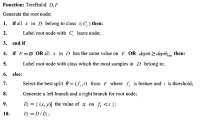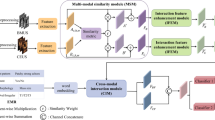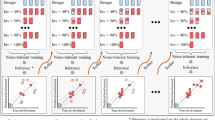Abstract
This paper proposes an ultrasound breast tumor CAD system based on BI-RADS features scoring and decision tree algorithm. Because of the difficulty of biopsy label collection, the proposed system adopts a few-shot learning method. The SVM classifier is employed to preliminarily mark the unlabeled cases firstly. Then these unlabeled cases with the pseudo labels are combined with the few real-labeled cases to train the decision tree. To test the performance of the proposed method, 1208 ultrasound breast images were collected, and three well-experienced clinicians and three interns evaluated these images according to the BI-RADS scoring scheme. All of the images are transformed into vectors such that the algorithm can process. The experimental results show that the system performance improves significantly with the help of pseudo-labeled data. Compared to the decision tree trained by the real-labeled cases only, when the number of real-labeled cases was 40, the accuracy, specificity, sensitivity of the proposed system were increased by 2.05%, 2.47% and 1.81%, respectively; the positive predictive value (PPV) and the negative predictive value (NVP) were increased by 1.29% and 3.05%, respectively. Meanwhile, the performance of the proposed method was the same as the method using sufficient samples. When the number of the labeled cases reached 100, the accuracy, specificity, sensitivity, PPV and NVP of the proposed method were 90.03%, 87.02%, 91.68%, 93.07%, and 85.03%, respectively. The results demonstrate that our method can efficiently distinguish the breast tumor although the labeled data is not sufficient.


Similar content being viewed by others
Explore related subjects
Discover the latest articles and news from researchers in related subjects, suggested using machine learning.References
Aminikhanghahi S, Shin S, Wang W, Jeon SI, Son SH (2016) A new fuzzy Gaussian mixture model (FGMM) based algorithm for mammography tumor image classification. Multimedia Tools & Applications 76(7):10191–10205
DeSantis C, Ma J, Bryan L, Jemal A (2014) Breast cancer statistics, 2013. CA Cancer J Clin 64(1):52–62
Feng X, Guo X, Huang Q (2016) Systematic evaluation on speckle suppression methods in examination of ultrasound breast images. Appl Sci 7(1):37
Guo Y, Ding G, Han J, Gao Y (2017) Zero-shot learning with transferred samples. IEEE Trans Image Process 26(7):3277–3290
Guo Y, Ding G, Liu L, Han J, Shao L (2017) Learning to hash with optimized anchor embedding for scalable retrieval. IEEE Trans Image Process 26(3):1344–1354
Han J, Chen C, Shao L, Hu X, Han J, Liu T (2015) Learning computational models of video memorability from fMRI brain imaging. IEEE Transactions on Cybernetics 45(8):1692–1703
Huang Q, Yang F, Liu L, Li X (2015) Automatic segmentation of breast lesions for interaction in ultrasonic computer-aided diagnosis. Inf Sci 314(C):293–310
Huang Q, Luo Y, Zhang Q (2017) Breast ultrasound image segmentation: a survey. Int J Comput Assist Radiol Surg 12(3):493–507
Huang Q, Huang X, Liu L, Lin Y, Long X, Li X, Case-oriented Web-based A (2017) Training system for breast Cancer diagnosis. Comput Methods Prog Biomed 156:73–83
Jesneck JL, Lo JY, Baker JA (2007) Breast mass lesions: computer-aided diagnosis models with mammographic and sonographic descriptors 1. Radiology 244(2):390–398
Kim J (2013) Breast cancer survivability prediction using labeled, unlabeled, and pseudo-labeled patient data. Journal of American Medical Informatics Association Jamia 20(4):613–618
Liberman L, Menell JH (2002) Breast imaging reporting and data system (BI-RADS). Radiologic Clinics 40(3):409–430
Liu X, Shi J, Zhou S, Lu M (2014). An iterated Laplacian based semi-supervised dimensionality reduction for classification of breast cancer on ultrasound images. Engineering in medicine and biology society (EMBC), 2014 36th annual international conference of the IEEE, 2014. IEEE, p 4679–4682
Liu J, Gu Y, Kamijo S (2017) Customer behavior classification using surveillance camera for marketing. Multimedia Tools & Applications 76(5):6595–6622
Loh WY (2011) Classification and regression trees. Wiley Interdisciplinary Reviews: Data Mining and Knowledge Discovery 1(1):14–23
Lu X, Li X, Mou L (2015) Semi-supervised multitask learning for scene recognition. IEEE Transactions on Cybernetics 45(9):1967–1976
Luo Y, Liu L, Huang Q, Li X (2017) A novel segmentation approach combining region-and edge-based information for ultrasound images. Biomed Res Int 2017:1–18
Nothacker M, Duda V, Hahn M, Warm M, Degenhardt F, Madjar H, Weinbrenner S, Albert U (2009) Early detection of breast cancer: benefits and risks of supplemental breast ultrasound in asymptomatic women with mammographically dense breast tissue. A systematic review BMC CANCER 9(1):335
Prabusankarlal KM, Thirumoorthy P, Manavalan R (2015) Assessment of combined textural and morphological features for diagnosis of breast masses in ultrasound. Human-centric computing and. Inf Sci 5(1):1–17
Quinlan JR (1986) Induction of decision trees. Mach Learn 1(1):81–106
Quinlan JR (1993). C4. 5: programs for machine learning. Morgan Kaufmann Series in Machine Learning, Morgan Kaufman Publishers
Shan J, Alam SK, Garra B, Zhang Y, Ahmed T (2016) Computer-aided diagnosis for breast ultrasound using computerized BI-RADS features and machine learning methods. Ultrasound Med Biol 42(4):980–988
Shen W, Chang R, Moon WK, Chou Y, Huang C (2007) Breast ultrasound computer-aided diagnosis using BI-RADS features. Acad Radiol 14(8):928–939
Shi J, Zhou S, Liu X, Zhang Q, Lu M, Wang T (2016) Stacked deep polynomial network based representation learning for tumor classification with small ultrasound image dataset. Neurocomputing 194(C):87–94
Su Y, Wang Y (2010). Computer-aided classification of breast tumors using the affinity propagation ClusteringBioinformatics and biomedical engineering (iCBBE), 2010 4th international conference on, 2010. IEEE, p 1–4
Tang J, Shao L, Li X (2014) Efficient dictionary learning for visual categorization. Comput Vis Image Underst 124:91–98
Tu E, Yang J, Kasabov N, Zhang Y (2015) Posterior distribution learning (PDL): a novel supervised learning framework using unlabeled samples to improve classification performance. Neurocomputing 157:173–186
Zhang G, Wang W, Shin S, Hruska CB, Son SH (2015) Fourier irregularity index: a new approach to measure tumor mass irregularity in breast mammogram images. Multimedia Tools & Applications 74(11):3783–3798
Zhang Q, Xiao Y, Dai W, Suo J, Wang C, Shi J, Zheng H (2016) Deep learning based classification of breast tumors with shear-wave elastography. Ultrasonics 72:150–157
Zhang D, Han J, Han J, Shao L (2016) Cosaliency detection based on intrasaliency prior transfer and deep intersaliency mining. IEEE Transactions on Neural Networks and Learning Systems 27(6):1163–1176
Zhang R, Nie F, Li X (2017). Semi-supervised classification via both label and side informationAcoustics, speech and signal processing (ICASSP), 2017 I.E. international conference on, 2017. IEEE, p2417–2421
Zhou S, Shi J, Zhu J, Cai Y, Wang R (2013) Shearlet-based texture feature extraction for classification of breast tumor in ultrasound image. Biomedical Signal Processing & Control 8(6):688–696
Acknowledgements
This work was partially supported by National Natural Science Foundation of China (Nos. 61372007 and 61571193), Guangzhou Key Lab of Body Data Science (No.201605030011), Natural Science Foundation of Guangdong Province, China (Nos. 2017A030312006 and 2015A030313210), Fundamental Research Funds for the Central Universities (NO.2015ZM138), Project of Science and Technology Department of Guangdong province (2014A050503020, 2016A010101021, 2016A010101022 and 2016A010101023), Science and Technology Program of Guangzhou (no. 201704020134).
Author information
Authors and Affiliations
Corresponding author
Rights and permissions
About this article
Cite this article
Huang, Q., Zhang, F. & Li, X. Few-shot decision tree for diagnosis of ultrasound breast tumor using BI-RADS features. Multimed Tools Appl 77, 29905–29918 (2018). https://doi.org/10.1007/s11042-018-6026-1
Received:
Revised:
Accepted:
Published:
Issue Date:
DOI: https://doi.org/10.1007/s11042-018-6026-1




